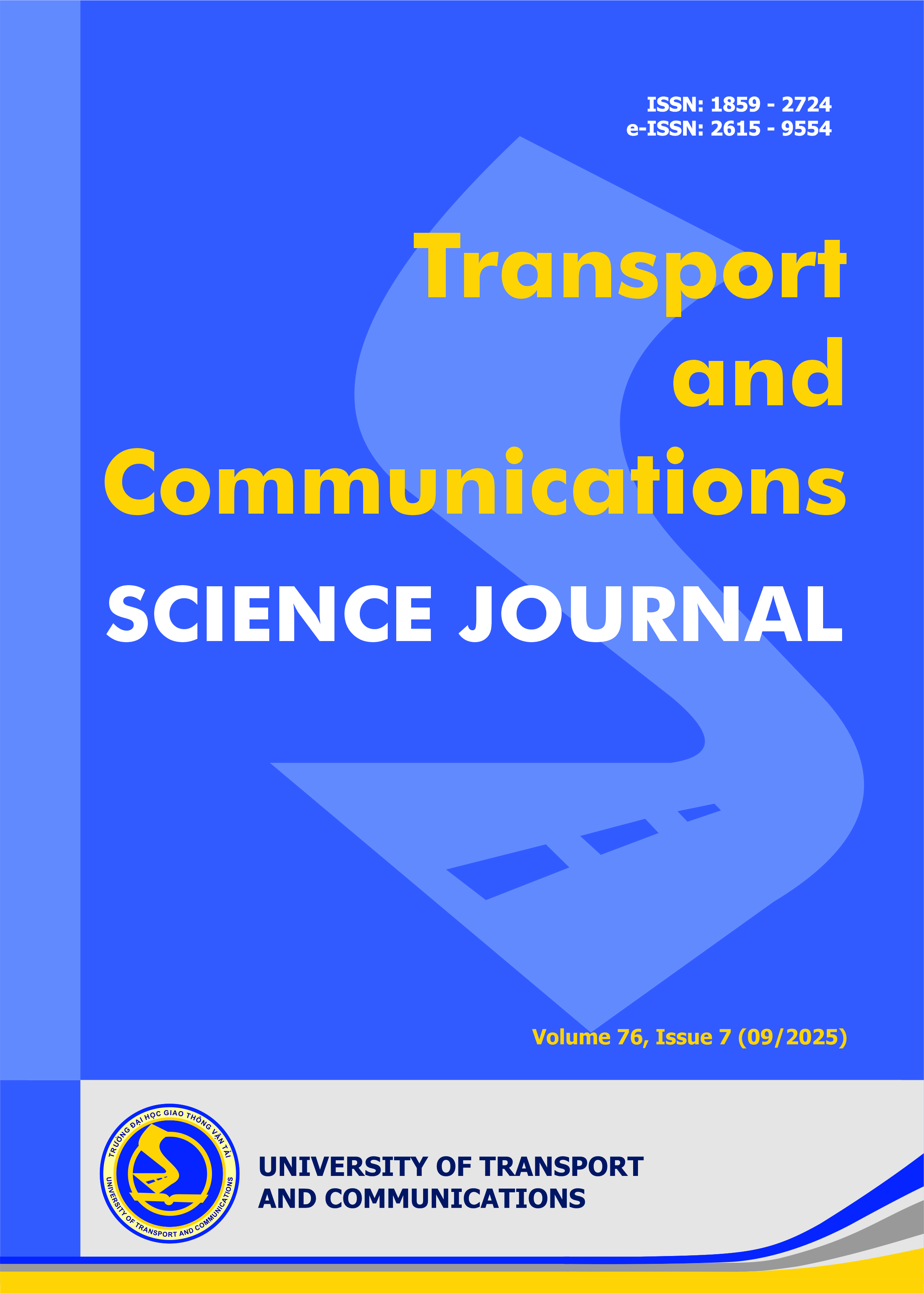An investigation of fly ash and lightweight sand on high-performance mortar
Email:
hung.nd2@vgu.edu.vn
Từ khóa:
high-performance mortar, fly ash, lightweight sand, internal curing, compressive strength, slump flow
Tóm tắt
A high-performance mortar with high compressive strength and high flow is often used for repairing cracks, filling in the gap of a splice sleeve, and joints of precast concrete structures. In this study, a high-performance mortar with a compressive strength greater than 80 MPa was designed based on traditional sand, cement, water, and industrial wastes such as fly ash from thermal power plants. The mortar mixtures were studied based on practical investigation. The traditional sand was then replaced by lightweight sand from black lava stone to investigate the internal curing effect. The mortar which included 29.7%, 19.8%, and 5.5% of the unit volume for traditional sand, lightweight sand, and fly ash, respectively, satisfied the strength requirement. A 1% superplasticizer by weight of cement was adequate to create a flowable mortar. A suitable amount of lightweight sand in a mortar mixture could contribute to the compressive strength of the high performance mortar through internal curingTài liệu tham khảo
[1]. H. K. Kim, Bond strength of mortar-filled steel splice reflecting confining effect, J. of Asian Arc. and Build. Eng., 11 (2012) 125-132.
[2]. J. Choi, S. K. Park, H. Y. Kim, S. Hong, Behavior of high-performance mortar and concrete connections in precast concrete elements: Experimental investigation under static and cyclic loadings, Eng. Struct., 100 (2015) 633-644. https://doi.org/10.1016/j.engstruct.2015.06.009
[3]. M. Ashok, A. K. Parande, P. Jayabalan, Strength and durability study on cement mortar containing nano materials, Adv. in Nano Res., 5 (2017) 99-111. https://doi.org/10.12989/amr.2019.8.2.137
[4]. C. S. Poon, L. Lam, Y. L. Wong, A study on high strength concrete prepared with large volumes of low calcium fly ash, Cement and Conc. Res., 30 (2000) 447-455. https://doi.org/10.1016/S0008-8846(99)00271-9
[5]. Y. Hu, S. Hu, B. Yang, S. Wang, Effects of subsequent curing on chloride resistance and microstructure of steam-cured mortar, Adv. in Conc. Constr., 9 (2020) 449-457. https://doi.org/10.12989/acc.2020.9.5.449
[6]. M. U. Salim, M. A. Mosaberpanah, Mechanical and durability properties of high-performance mortar containing binary mixes of cenosphere and waste glass powder under different curing regimes, J. of Mater. Res. and Tech., 13 (2021) 602-617. https://doi.org/10.1016/j.jmrt.2021.04.077
[7]. A. S. Shawkat, T. E. Dawood, Production of high-performance mortar containing metakaoline and silica fume, Int. J. of Progressive Sci. and Tech., 21 (2020) 32-39.
[8]. K. R. Patra, B. B. Mukharjee, Influence of granulated blast furnace slag as fine aggregate on properties of cement mortar, Adv. in Conc. Constr., 6 (2018) 611-629. https://doi.org/10.12989/acc.2018.6.6.611
[9]. S. C. Yaragal, M. A. K. Roshan, Usage potential of recycled aggregates in mortar and concrete, Adv. in Conc. Constr., 5 (2017) 201-219. https://doi.org/10.12989/acc.2017.5.3.201
[10]. G. J. P. Venkatesh, S. S. Vivek, G. Dhinakaran, Study on compressive strength of self compacting mortar cubes under normal & electric oven curing methods, IOP Conf. Ser.: Earth Environ. Sci., 80 (2017) 012002. https://doi.org/10.1088/1755-1315/80/1/012002
[11]. D. H Nguyen, L. Mai, T. H. Nguyen, Combining internal and external curing to improve quality of self-compacting concrete with consideration of climate effects, Adv. in Conc. Constr., 12 (2021) 85-91. https://doi.org/10.12989/acc.2021.12.2.085
[12]. W. Guan, Q. Qi, Z. Zhang, S. Nan, Effect of sand particle size on microstructure and mechanical properties of gypsum-cemented similar materials, Materials, 13 (2020). https://doi.org/10.3390/ma13030765
[13]. ASTM International, Standard Specification for Concrete Aggregates, ASTM C33/C33M-18, 2018.
[14]. ASTM International, Standard Terminology Relating to Concrete and Concrete Aggregates, ASTM C125-21a, 2021.
[15]. ASTM International, Standard Test Method for Density, Relative Density (Specific Gravity), and Absorption of Fine Aggregate, ASTM C128-22, 2022.
[16]. W. H. J. Tchamdjou, S. Grigoletto, F. Michel, L. Courard, M. L. Abidi, T. Cherradi, An investigation on the use of coarse volcanic scoria as sand in Portland cement mortar, Case Studies in Constr. Mater., 7 (2017) 191-206. https://doi.org/10.1016/j.cscm.2017.07.005
[17]. M. Vyšvařil, P. Bayer, P. Rovnaníková, Use of Lava Sand as an Alternative to Standard Quartz Aggregate in Lime Mortars, Solid State Phenomena, 296 (2019) 73-78. https://doi.org/10.4028/www.scientific.net/SSP.296.73
[18]. L. Contrafatto, C. L. Danzuso, S. Gazzo, L. Greco, Physical, mechanical and thermal properties of lightweight insulating mortar with recycled Etna volcanic aggregates, Constr. and Build. Mater., 240 (2020) 117917. https://doi.org/10.1016/j.conbuildmat.2019.117917
[19]. H. Binici, O. Aksogan, E. B. Gorur, H. Kaplan, M. N. Bodur, Performance of ground blast furnace slag and ground basaltic pumice concrete against seawater attack, Constr. and Build. Mater., 22 (2008) 1515-1526. https://doi.org/10.1016/j.conbuildmat.2007.03.024
[20]. C. C. Banand, M. Ramli, Optimization of mix proportion of high-performance mortar for structural applications, American J. of Eng. and Appl. Sci., 3 (2010) 643-649.
[21]. M. M. Islam, M. S. Islam, Strength behaviour of mortar using fly ash as partial replacement of cement, Conc. Res. Letters, 1 (2010) 98-106.
[22]. S. Kurbetci, M. Nas, M. Şahin, Durability properties of mortars with fly ash containing recycled aggregates, Adv. in Conc. Constr., 13 (2022) 101-111. https://doi.org/10.12989/acc.2022.13.1.101
[23]. ASTM International, Standard Specification for Flow Table for Use in Tests of Hydraulic Cement. ASTM C230/C230M-21, 2021.
[24]. EFNARC, specification and guidelines for self-compacting concrete. European Federation for Specialist Construction Chemicals and Concrete Systems, Norfolk, UK, English Eds., Feb. 2002.
[25]. ASTM International, Standard Test Method for Compressive Strength of Hydraulic Cement Mortars (Using 2-in. or [50-mm] Cube Specimens), ASTM C109/C109M-21, 2021.
[2]. J. Choi, S. K. Park, H. Y. Kim, S. Hong, Behavior of high-performance mortar and concrete connections in precast concrete elements: Experimental investigation under static and cyclic loadings, Eng. Struct., 100 (2015) 633-644. https://doi.org/10.1016/j.engstruct.2015.06.009
[3]. M. Ashok, A. K. Parande, P. Jayabalan, Strength and durability study on cement mortar containing nano materials, Adv. in Nano Res., 5 (2017) 99-111. https://doi.org/10.12989/amr.2019.8.2.137
[4]. C. S. Poon, L. Lam, Y. L. Wong, A study on high strength concrete prepared with large volumes of low calcium fly ash, Cement and Conc. Res., 30 (2000) 447-455. https://doi.org/10.1016/S0008-8846(99)00271-9
[5]. Y. Hu, S. Hu, B. Yang, S. Wang, Effects of subsequent curing on chloride resistance and microstructure of steam-cured mortar, Adv. in Conc. Constr., 9 (2020) 449-457. https://doi.org/10.12989/acc.2020.9.5.449
[6]. M. U. Salim, M. A. Mosaberpanah, Mechanical and durability properties of high-performance mortar containing binary mixes of cenosphere and waste glass powder under different curing regimes, J. of Mater. Res. and Tech., 13 (2021) 602-617. https://doi.org/10.1016/j.jmrt.2021.04.077
[7]. A. S. Shawkat, T. E. Dawood, Production of high-performance mortar containing metakaoline and silica fume, Int. J. of Progressive Sci. and Tech., 21 (2020) 32-39.
[8]. K. R. Patra, B. B. Mukharjee, Influence of granulated blast furnace slag as fine aggregate on properties of cement mortar, Adv. in Conc. Constr., 6 (2018) 611-629. https://doi.org/10.12989/acc.2018.6.6.611
[9]. S. C. Yaragal, M. A. K. Roshan, Usage potential of recycled aggregates in mortar and concrete, Adv. in Conc. Constr., 5 (2017) 201-219. https://doi.org/10.12989/acc.2017.5.3.201
[10]. G. J. P. Venkatesh, S. S. Vivek, G. Dhinakaran, Study on compressive strength of self compacting mortar cubes under normal & electric oven curing methods, IOP Conf. Ser.: Earth Environ. Sci., 80 (2017) 012002. https://doi.org/10.1088/1755-1315/80/1/012002
[11]. D. H Nguyen, L. Mai, T. H. Nguyen, Combining internal and external curing to improve quality of self-compacting concrete with consideration of climate effects, Adv. in Conc. Constr., 12 (2021) 85-91. https://doi.org/10.12989/acc.2021.12.2.085
[12]. W. Guan, Q. Qi, Z. Zhang, S. Nan, Effect of sand particle size on microstructure and mechanical properties of gypsum-cemented similar materials, Materials, 13 (2020). https://doi.org/10.3390/ma13030765
[13]. ASTM International, Standard Specification for Concrete Aggregates, ASTM C33/C33M-18, 2018.
[14]. ASTM International, Standard Terminology Relating to Concrete and Concrete Aggregates, ASTM C125-21a, 2021.
[15]. ASTM International, Standard Test Method for Density, Relative Density (Specific Gravity), and Absorption of Fine Aggregate, ASTM C128-22, 2022.
[16]. W. H. J. Tchamdjou, S. Grigoletto, F. Michel, L. Courard, M. L. Abidi, T. Cherradi, An investigation on the use of coarse volcanic scoria as sand in Portland cement mortar, Case Studies in Constr. Mater., 7 (2017) 191-206. https://doi.org/10.1016/j.cscm.2017.07.005
[17]. M. Vyšvařil, P. Bayer, P. Rovnaníková, Use of Lava Sand as an Alternative to Standard Quartz Aggregate in Lime Mortars, Solid State Phenomena, 296 (2019) 73-78. https://doi.org/10.4028/www.scientific.net/SSP.296.73
[18]. L. Contrafatto, C. L. Danzuso, S. Gazzo, L. Greco, Physical, mechanical and thermal properties of lightweight insulating mortar with recycled Etna volcanic aggregates, Constr. and Build. Mater., 240 (2020) 117917. https://doi.org/10.1016/j.conbuildmat.2019.117917
[19]. H. Binici, O. Aksogan, E. B. Gorur, H. Kaplan, M. N. Bodur, Performance of ground blast furnace slag and ground basaltic pumice concrete against seawater attack, Constr. and Build. Mater., 22 (2008) 1515-1526. https://doi.org/10.1016/j.conbuildmat.2007.03.024
[20]. C. C. Banand, M. Ramli, Optimization of mix proportion of high-performance mortar for structural applications, American J. of Eng. and Appl. Sci., 3 (2010) 643-649.
[21]. M. M. Islam, M. S. Islam, Strength behaviour of mortar using fly ash as partial replacement of cement, Conc. Res. Letters, 1 (2010) 98-106.
[22]. S. Kurbetci, M. Nas, M. Şahin, Durability properties of mortars with fly ash containing recycled aggregates, Adv. in Conc. Constr., 13 (2022) 101-111. https://doi.org/10.12989/acc.2022.13.1.101
[23]. ASTM International, Standard Specification for Flow Table for Use in Tests of Hydraulic Cement. ASTM C230/C230M-21, 2021.
[24]. EFNARC, specification and guidelines for self-compacting concrete. European Federation for Specialist Construction Chemicals and Concrete Systems, Norfolk, UK, English Eds., Feb. 2002.
[25]. ASTM International, Standard Test Method for Compressive Strength of Hydraulic Cement Mortars (Using 2-in. or [50-mm] Cube Specimens), ASTM C109/C109M-21, 2021.
Tải xuống
Chưa có dữ liệu thống kê

Nhận bài
20/02/2022
Nhận bài sửa
14/05/2025
Chấp nhận đăng
10/09/2025
Xuất bản
15/09/2025
Chuyên mục
Công trình khoa học
Kiểu trích dẫn
Nguyen Dinh, H., & Tran Ngoc, L. (1757869200). An investigation of fly ash and lightweight sand on high-performance mortar. Tạp Chí Khoa Học Giao Thông Vận Tải, 76(7), 1023-1033. https://doi.org/10.47869/tcsj.76.7.8
Số lần xem tóm tắt
91
Số lần xem bài báo
25









